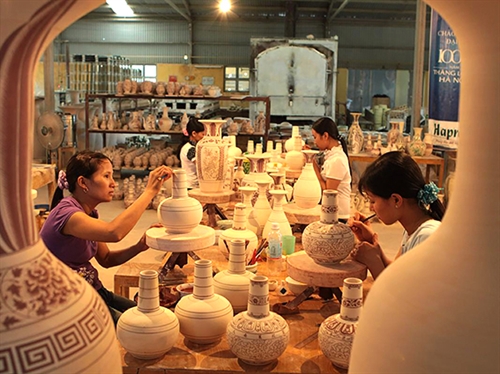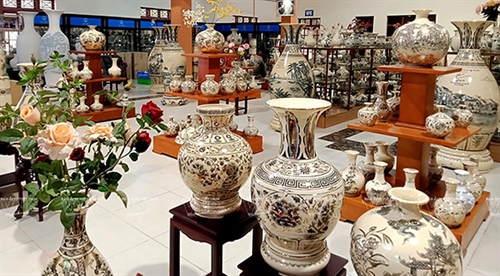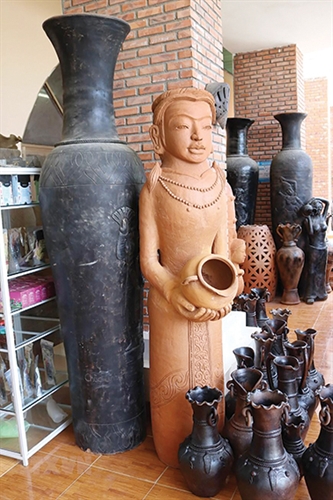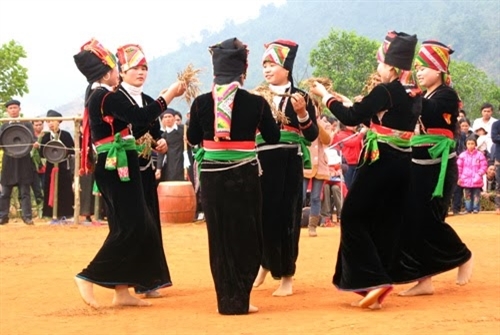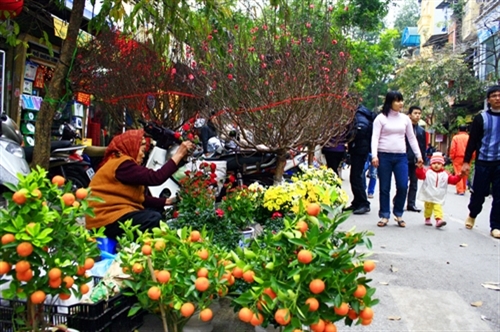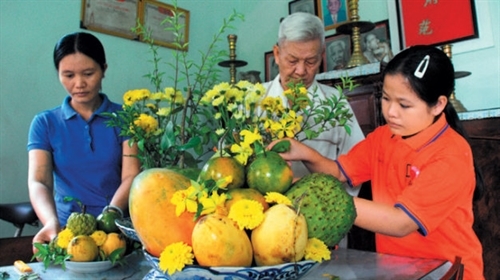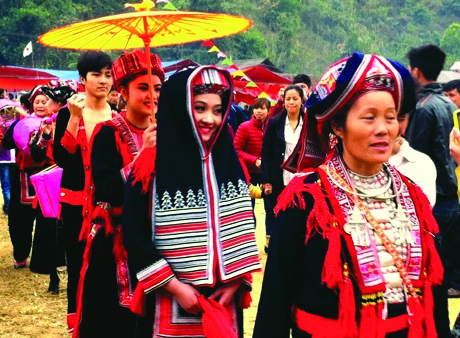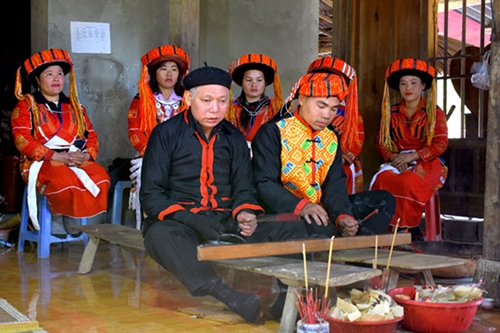Ta Thi Tam, M.A.
Institute of Anthropology, Vietnam Academy of Social Sciences
The Nung, the 7th largest ethnic group in Vietnam with a population of over one million, formed subgroups with different names but having the Nung prefix in common such as Nung An, Nung Inh, Nung Chao, Nung Quy Din, and Nung Loi.
Weaving is the most important craft in the Nung’s life. It is handed down from mother to daughter. All Nung families used to have looms and the number of looms equaled to that of daughters they had. Apart from housework and child care and nurturing, Nung women have to be good at cotton cultivation and weaving. That’s why Nung women teach their daughters how to grow and weave cotton at a very young age. When a girl gets married, she can weave cloth to make clothes for other members of her own family or exchange them for other family items.
From a cotton seed to make a plain weave cloth, the Nung have to take many steps from cotton growing to spinning, sizing and weaving.
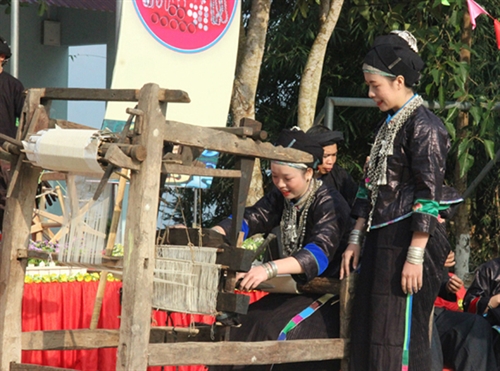 |
| A Nung woman in Xin Man district, Ha Giang province, performs the group’s traditional weaving techniques__Photo: baohagiang.vn/ |
Cotton growing
Nung people usually grow cotton in late second lunar month or early third lunar month and it takes about four months to grow a cotton-bearing plant from seed. Carefully selected dried seeds are dried out again and mixed with ash before sowing. Twenty days after sowing or when cotton plants are about 10cm high, Nung people come to the fields to pull off all weeds and fertilize the soil. Weeding must be done thrice from germination to harvest to keep healthy plants to flower. The flowers’ petals fall off, leaving the ovaries on the plants to ripen and grow into cotton bolls. Once these bolls burst open, the cotton dries when exposed to the sun. Therefore, Nung people usually pick cotton bolls in the middle of the day. After that, cotton bolls are dried out again and then kept in bamboo baskets.
Ginning
The weaving process always begins with the ginning. To pinch cotton fiber from seeds, Nung women use a small double-roller wooden gin. Powered by one-hand crank, the two rollers, which are about four centimeters in diameter, are wedged together by the gin into a 45cm-high vertical frame and are counter rotated. As the rollers turn, they pull cotton fiber between them while pinching the seeds off the fiber tufts. The seeds cannot pass through the tightly wedged rotating rollers and so drop away as the fiber passes between the two rollers. This action effectively separates fiber from seeds. Though ginning is quite simple and does not require complicated technique, it often takes a whole day to separate merely about two kilograms of raw ginned cotton, called lint, from cotton seeds.
Bowing
In this process, Nung people put the raw ginned cotton on a large bamboo-woven mat and use a small heavy wooden tool to flick the bowstring in order to tease the lint apart and make it into nice, fluffy clouds. As bowing is a relatively hard job, Nung men often do it for their mothers and wives.
Rolling
Placed on smooth thin boards, the cotton clouds are separated into bits, about 20cm long, and rolled around smooth bamboo sticks to form cotton rolls. These are made nice and firm and tightly packed before the sticks are removed.
Spinning
Nung people use a wheel-driven bamboo or iron spindle to spin cotton into yarn. The spindle is fixed on a 20cm-high hollow curved log at one side of a 60cm-long base of a winding tool while the other side is a 60cm-diameter drive wheel hub fixed on two 50cm-long drive wheel supports.
To begin the spinning process, a Nung woman takes a small piece of lint and winds it tightly over the point of the spindle. The drive wheel is then turned with her right hand while the lint is spun and winded with her left hand by stretching out and pulling back the cotton roll. During this process, she has to maintain a steady speed to avoid twisting the yarn and move the yarn along the spindle so that yarn winds onto the spindle evenly to prevent it from tangling. Sometimes she has to turn the drive wheel in the opposite direction to avoid uneven and tangled yarn and keep an even twist.
Next, the woman uses a simple wooden spinning wheel to make handspun singles. The spinning wheel has two 30cm-diameter drive wheels fixed on two 40cm-high drive wheel supports and at one drive wheel hub which is attached to a hand crank. Each drive wheel has four crossed drive wheel spokes. The end of a drive wheel spoke of one drive wheel is tied to the end of a drive wheel spoke of the other drive wheel by a thread to create a V-shaped angle.
A handspun single of yarn weighing between half a kilogram and one kilogram is made when a Nung spinner holds the yarn spindle connected to the drive wheels with one hand while rotating the crank with the other hand. Once finished, the two ends of the skein of yarn are tightly twisted to prevent the yarn from tangling.
Sizing
To make the cotton yarn strong, durable, shiny and abrasion resistant, the Nung dip their handspun singles into a large cool pot of non-glutinous rice soup which is thoroughly cooked with bee wax. After that, they hang them out in shady places to dry and tap the yarn with a stick to separate strands.
Weaving
Nung weavers use a rectangular wooden or bamboo loom which is 220cm long, 120cm wide, 150cm (at one end) and 50cm (at the other end) high to weave a cloth. The loom’s width depends of a cloth’s size which can be either 30cm or 50cm. The two-treadle loom consists of a cloth beam tied to its pole; a weaver’s seat which is fixed at the lower end of the loom; shed rods that are used to maintain the crossing of the warp’s threads; a heddle stick that is used to lift alternate threads of the warp; battens that help separate alternate threads of the warp to allow the bobbin to pass through them; and a bobbin that contains the thread of the weft and passes from side to side between the warp. The shuttle of the loom that is used to carry the weft thread across the loom decides the size of the cloth while loom bars are used to hold the warp (vertical threads) to the upper and lower ends of the loom and the back strap is worn around the weaver’s back and connects her to the loom.
When warp-faced weaving on the loom, a Nung woman sits on the seat and wears the back strap around her lower back to stretch tautly the warp threads. For each treadle, she can add one thread to the weft by using one hand to pass the bobbin through the warp threads and the other hand to beat the thread into the right place with a batten. When the cloth is about 20cm long, she will roll up the loom bar and roll-up stick in front of her belly and continues weaving. It usually takes the weaver a whole day to weave two arm spans of plain weave cloth and three to four days to weave a plain weave cloth long enough to make a set of trousers and blouse.-
